Print at Home Version [read this first]
Please play my game before reading any of this report from “Overview” on down. The whole concept of my game – what makes it interesting – hinges on the player not quite yet knowing where I’m going to go with the story. If you read the entire report first, that effect is ruined.
My print at home version comes in three different parts.
- The rulebook (start here, until it says to stop reading). Here as a higher quality PDF, just note it’s out of order since I made it in booklet form.
- The cards (4*9=32 cards for four different wild cats, to be printed 2x for a total of 64 cards)
- A cheatsheet/reference table to create transparency about the wild cats intellectual prowess – since in this game it’s about potential of the mind, not the paws.
Plus, finally, the video walkthrough link. Let me know if this still doesn’t work.
Overview
I thought long and hard what “serious” issue I might highlight in my game. As has probably become obvious, I’m very interested in politics. Combined with the instruction to do something that as its target audience has “college kids,” I decided to focus on affirmative action. The topic touches young lives more so than anyone else, so i’s important that children and adolescents think about this. They make decisions which may majorly impact their life trajectory very soon (such as, by 18, deciding what college to apply to and hopefully attend), but also career decisions once in college. Both are majorly impacted by affirmative action and related policies, and as such, this is a key issue for our generation on which we should be knowledgeable. For a mid-career professional who’ll most likely be hired for a distinct skill and not their university name or demographic, the topic is probably slightly less crucial.
So I decided to take on the area, even though I know it’s quite a controversial one, and even though I feel quite ambivalent about the intricacies of affirmative action myself. I’m a big believer in equal opportunity and favor government intervention that makes opportunity more abundant for individuals who may traditionally not have been given a chance. Then, on the other side, I worry that ethnicity-based preferences are the stuff that civil wars are made of (Sri Lanka, Burma, etc.): lumping people into groups based on ethnicity, esp. without a clear exit condition, seems like a potentially scary prospect that runs contrary to some of the great principles the United States is built on.
Many an American friend and strong affirmative action proponent would argue that, as an outsider in U.S. society, I simply do not quite understand the legacy of slavery and how deep-rooted it is. And I sympathize with this argument: the U.S. school system seems to fail many, and not tapping that human potential limits agency and self-determination. But then again, the outsider in me also can’t help but remember that we in Europe committed outright atrocities on the basis of religion and ethnicity – often thinking we’re doing “the right thing.”
As such, I decided to design a game that doesn’t give a simple answer, but shows some of the risks of where affirmative action is going, while also encouraging reflection on the side of players over why it may be necessary. Generally, I think that honesty and transparency is the best path for people to make their own quality decisions, so I decided to shed light on the scale of affirmative action at Harvard over the last few years. The game targets young people, and is designed for 1-2 players to allow for ample reflection: I think it’s fun, but it’s certainly not a party/group game. Just as the “Precision of Emotion” reading discussed, I see fun in this case to be in the learning, in comprehension – and additionally, in astonishment. Being surprised is fun, and in this case it’s even more useful: by not making the game about affirmative action at first, I hope to reach people that would otherwise wall off early on since it’s such a heated debate.
I hope to reach everyone by not telling people what to think, but to simply highlight how aggressively some of these affirmative actions policies need to be designed to level the field (that realization is what I’m measuring – more on that in “Assessment Goals”), and thereby instead get people thinking of ways to ensure the playing field is never that lopsided in the first place – hopefully.
Rules
Please see “Premise” on pages 2 and 3 of the rulebook, as well as “Rules” on page 3 for the exact rules.
Game Bits
- 1x Rulebook
- 2x Reference Table of Chances
- 18x Snow Leopard Cards
- 18x Tiger Cards
- 18x Lion Cards
- 18x Jaguar Cards
Assessment Goals
Since I don’t know another game just like it (I did some research when crafting the concept statement), and thus my biggest concern is that people may not question their beliefs or that people will default to being offended instead of using any discomfort felt as a catalyst for critical thought, since I don’t have a great example to look up to.
My solution to that is: I am really not focused on some learning outcome being something like “I want people to definitely think x.” Instead, I’m focused on that people should know how large in scope some of these affirmative action policies have been as my learning outcome. I’m hoping that people will conclude that the sustainable path forward is through closing gaps in scholastic attainment.
I find it heartbreaking that such significant differences in SAT scores and GPAs persist between different groups in the US and think that instead of failing low-income families early on and then trying to fix things after the fact in admissions when people have already been set up for failure (or at least set up for a tough time catching up), more focus should be on ensuring these differences never emerge.
But that is beyond the realistically measurable: thought are free, and my game is nothing but a soft nudge. So what I do measure instead is the knowledge people come in with, and the knowledge people go out with. And to make sure the “starting in a neutral spot” plan (which made me chose the wild cat theme instead of making this about humans) is working successfully, I’m also checking if people have a suspicion after reading pages 2 and 3 of the rulebook what the game is about.
In early playtests, I have just focused on the conversation and asking people questions and observing, and in the last two playtests, I had a Google form, with the following 4 questions:
- Pre-Play: Having read nothing but the first two pages of the rulebook, what do you think the game is about?
- Pre-Play: What do you know about affirmative action? Roughly how many times more/less likely is an e.g. black applicant vs. white applicant to be admitted given objectively similar academic performance?
- Post-Play: What do you know about affirmative action? Roughly how many times more/less likely is an e.g. black applicant vs. white applicant to be admitted given objectively similar academic performance?
- Post-Play: Anything else you want to say/that’s on your mind?
Versions of the Game & Playtests
V1: Tiny Playable Prototype I
Description of Game and Changes:
Mini-cards with just the animals: 4 cards for Tiger, 4 cards for Lion. I came up with the simple “standoff mechanic” (i.e. one player’s card against other player’s card, and one wins – even though that’s of course a gross oversimplification) for this game already. That stayed the same throughout the rest of the game. But instead of the “chance of admission/becoming a leader” (i.e. chance of winning), they only had the decile/performance score from 1 to 10. I thought it would be simpler this way, but then every “standoff” required a lookup in an extra table of what card would win. I did no yet realize though since with the 8 cards, I had it all in my head (and neither did my play-tester).
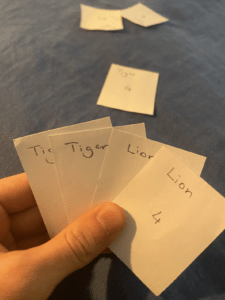
Playtest:
1 Playtester:
- Abel R., 23: originally Dutch, from new York, studied PoliSci and Computer Science, interested in Cybersecurity and Data Science
Insights:
- Cool idea with animals to make approachable but so far confusing how it translates to Affirmative Action, only got connection “because you explained all that”
- Not incredibly fun – it’s short enough to be interesting, but little interaction between players – Abel highlights this!
V2: First Full Prototype + Tiny Prototype II
I created a first full prototype: color-coded cards with animal portraits on them. Still decile/performance scores from 1 to 10. So for the first time created and printed the “cheatsheet” (i.e. reference sheet) to translate the decile scores to actual points and create the transparency needed for people to get the affirmative action connection, and wrote the first rulebook (again very clear at first focusing on animals, and only connect to affirmative action later so people are more open to it).
Introduced the dynamic that one person has to start, and that they have to say what wild cat they just placed on the table, so that there’s a bit more interaction and “strategy” in the game since you can react; since you know what card the player has played and therefore if it’s likely strong, you may decide to just get rid of a weak card on your hand, or whether to try to win this round. You can of course also be mislead since the weakest Lion is still a weak card and you don’t know which one it is.
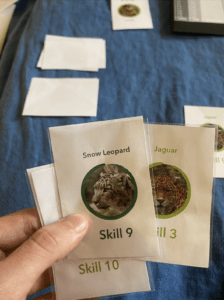
Playtest:
2 Playtesters:
- Juliane K. 24, from Austria, Education Science, left-leaning, just became a mom
- Adam S. 23, from Florida, centrist, studied bio computation/engineering, working on a startup
Insights:
- Realized during playtest that looking things up was too complicated, so created a few new cards (see additional photo below) to tiny-prototype on the fly: new concept to use actual chance numbers/probabilities comes from here so the table is only to inform players, doesn’t need to be continuously referenced
- Playtesters were confused that it’s all the “same color” (I used different shades of green which I thought was aesthetic)
- One of them likes the fact I don’t hit them immediately with “affirmative action,” and says the questions I asked after made them think about the pros and cons of affirmative action policies
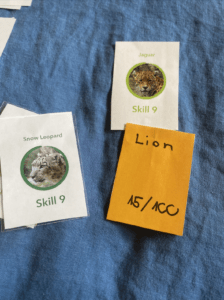
V3: Final Version I (Mostly Same Rules as V2)
This version has upgraded, beautifully designed cards. They now involve both the “skill level” that’s not actually needed during gameplay but needed to drive home the point that I want to make about the potential risks of affirmative action, and the chances/probabilities of being picked for easy reference. Also, I added radically different colors to make sure no one is confused.
Lastly: I created a rulebook in a pretty, black design. The content is largely the same, but I hashed out the story a bit more, and I changed the rules so that the winning cards need to stay on the table in front of the person so that it’s easier to look at them again and notice that at the end, it’s going to me mostly Jaguar and Lion cards who won, while there’s zero or one Tiger card(s) at most.
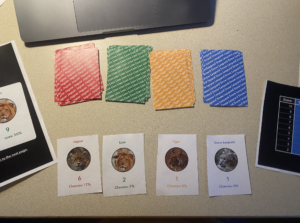
Playtest:
1 Playtester:
- Martha M., 27, Art Historian, Social Democrat, American from Maine but also lived abroad in UK for 5 years
Insights:
- Thinks it leaves enough room for personal interpretation while highlighting the numbers, esp. given the final chapter
- Thinks it’s interesting setup for a game, more like a mini paper with a game component
- Doesn’t like that I have chosen a “Savannah” as the setting -> esp. since much of the affirmative action discussion surrounds African Americans.
- Confused that I ask people to shuffle the cards -> Why shuffle and then separate again?
Learning Goals (Google Form):
- Q1: Sadly I made the mistake of telling her what it’s about, so n/a on Q1.
- Q2: Black student is significantly more likely to get admitted given similar academic preparedness
- Q3: Black student is far more likely to get admitted given similar academic preparedness, “I knew this but I was still astonished how large the factor is” -> no wonder Asians are mad.
V4: Final Version II (Updated Rules)
This version is more polished: I have rephrased a lot of the rules and made them more clear, I have cut some of the language that could be misinterpreted (it’s now “Animal Kingdom,” no longer the Savannah – which should be ok since I’ve renamed the P3 to no longer be called Animal Kingdom, wouldn’t want to be accused of plagiarism).
Also, I have made significant improvements to clarifying the rules for single players vs. two players in a visually pleasing way inside the rule booklet. As well as instructions when exactly to draw extra cards, and what to shuffle, etc. etc. to avoid any of the last confusions that came up. Last, but not least, I have doubled the number of cards to 18 per animal for slightly longer gameplay and making it less predictable/harder to keep it in mind how many strong/weak cards are left inside each stack.
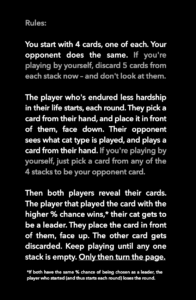
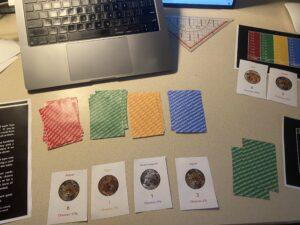
Playtest:
1 Playtester:
- Flurin A., 28, Head of Sales, Centrist, from Switzerland, lived in the United States for 3 years, married to an African American woman
Insights:
- Last problem: Flurin was a bit challenged since 4 cards in front of him: “Do I need to draw another one first, or first play?” (made fix in final version uploaded)
- Thought it was fun to play, reading the booklet and learning the facts on a topic he knew absolutely no numbers about (never went to school in the US)
Learning Goals (Google Form):
- Q1: It’s about winning. Oh, and maybe it’s about learning something about these animals?
- Q2: No clue – maybe there’s a tiny bonus since they have it harder?
- Q3: Depending on the background by a factor 3 to a factor 10
- Q4: Thinks affirmative action is unfair as it makes it significantly harder for the most capable students to be accepted by college depending on ethnicity (a very Swiss view indeed…)
Closing Thoughts
Creating this was a lot of fun, but also a lot of work by myself. If I had more time, I’d have liked to do an additional 1-2 playtests to get more representative data. I think setting this up as a game that’s meant to be played once and where part of the fun and part of the “food for thought” comes from the (thinly or not-so-thinly veiled) plot twist (depending on how perceptive a player is) and where one is guided through the experience by the little booklet is innovative and interesting, but didn’t make it easier to find “fresh testers.”
As such, I also want to acknowledge that I have relied on friends back in Switzerland (where, now that most of my undergrad friends at Stanford have graduated, a lot of my support ecosystem lies) for the playtests. That’s why the recent pictures of the second round of re-design and playtests are in front of my computer, I have played remotely with some of them, sending them the materials or playing through Zoom. But I want to highlight that I did the playtests to the best of my ability, it’s a bit tougher over break and in Week 9 outside of class. I of course understand the limitations of playtests or any kind of user research over Zoom, but hope that’s ok since it’s just 1 of 4 projects this quarter. If there are any concerns, happy to share the responses to the Google forms and my notes from early playtests.
Photos of Packaging
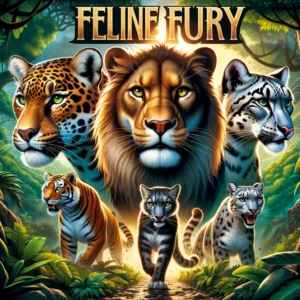
Credit: GPT 4.0 (DALLE) generated. But I had to prompt it for so long, it was actual work. It didn’t want to strike the balance between “super family friendly” and “violent wild animals.” Guess it’s time to pay up for Stable Diffusion. Sides of packaging not designed, the cards don’t need a full box anyways. An envelope would suffice.

